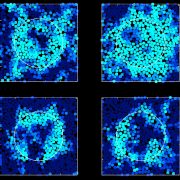The growth of amorphous order in supercooled liquids
Close to the glass transition supercooled liquids display an impressive increase of the relaxation time, without any clear sign of growing thermodynamic order, nor correlation length. This is at variance with physical intuition, which suggests that a large relaxation time is always associated to a large correlation length. Even though dynamical length scales were introduced and measured, nothing similar was thought to be possible for thermodynamic lengths.
We have found a way to detect the growth of amorphous order in supercooled liquids by using a smartly chosen, non-standard order parameter. In this way it was possible to measure for the first time a thermodynamic correlation length and show that it grows significantly in the low temperature phase.
Moreover, it was possible to detect a thermodynamic anomaly in the relaxation of this order parameter, able to distinguish at a qualitative level the low temperature phase from the high temperature one in supercooled liquids. Up to now, this was only possible by means of dynamical measurements, not thermodynamical ones. Our results, thus, opens the way to a new thermodynamical description of the low temperature phase of supercooled liquids.
We are also trying to measure the surface tension between different amorphous phases in deeply supercooled liquids. In this way we are able to detect the temperature where the surface tension goes to zero, and compare it with the Mode Coupling transition temperature. Finally, the large fluctuations in the surfece tension that we find, can be put in direct connection with the relaxation mechanism of supercooled liquids.
In 2009 I wrote an easy review on supercooled liquids and the glass transition. You can find it here.
RECENT PUBLICATIONS:
G. Biroli, J.-P. Bouchaud, A. Cavagna, T. S. Grigera, P. Verrocchio
Nature Physics 4, 771 – 775 (2008)
C. Cammarota, A. Cavagna
Journal of Chemical Physics 127, 214703 (2007)
A. Cavagna, T. S. Grigera and P. Verrocchio
Physical Review Letters 98, 187801 (2007)
If you are a student and you are interested in this topic, please contact Andrea Cavagna.


